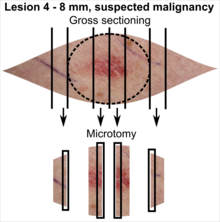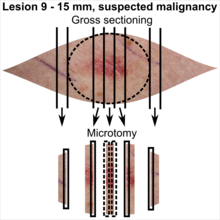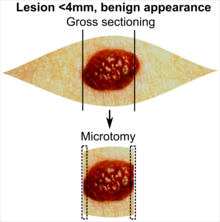Skin biopsy
| Skin biopsy | |
|---|---|
 Punch biopsy | |
| ICD-9-CM | 86.11 |
Skin biopsy is a
There are four main types of skin biopsies: shave biopsy, punch biopsy, excisional biopsy, and incisional biopsy. The choice of the different skin biopsies is dependent on the suspected diagnosis of the skin lesion. Like most biopsies,
Types
Shave biopsy
A shave biopsy is done with either a small
Punch biopsy

A punch biopsy is done with a circular blade ranging in size from 1 mm to 8 mm. The blade, which is attached to a pencil-like handle, is rotated down through the epidermis and dermis, and into the
Incisional biopsy
In an incisional biopsy a cut is made through the entire dermis down to the subcutaneous fat. A punch biopsy is essentially an incisional biopsy, except it is round rather than elliptical as in most incisional biopsies done with a scalpel. Incisional biopsies can include the whole lesion (excisional), part of a lesion, or part of the affected skin plus part of the normal skin (to show the interface between normal and abnormal skin). Incisional biopsy often yield better diagnosis for deep pannicular skin diseases and more subcutaneous tissue can be obtained than a punch biopsy. Long and thin deep incisional biopsy are excellent on the lower extremities as they allow a large amount of tissue to be harvested with minimal tension on the surgical wound. Advantage of the incisional biopsy over the punch method is that hemostasis can be done more easily due to better visualization. Dog ear defects are rarely seen in incisional biopsies with length at least twice as long as the width.[citation needed]
Excisional biopsy
An excisional biopsy is essentially the same as incisional biopsy, except the entire lesion or tumor is included. This is the ideal method of diagnosis of small melanomas (when performed as an excision). Ideally, an entire melanoma should be submitted for diagnosis if it can be done safely and cosmetically. This
| Lesion size | |||
|---|---|---|---|
| <4 mm | 4 – 8 mm | 9 – 15 mm | |
| Benign appearance | |||
| Suspected malignancy | 
|

|

|
In table above, each top image shows recommended lines for cutting out slices to be submitted for further processing. Bottom image shows which side of the slice that should be put to microtomy. Dashed lines here mean that either side could be used. The entire specimen may be sliced and submitted if the risk of malignancy is high.[3] Otherwise the rest may be saved in fixation in case microscopy indicates further sampling.[citation needed]
Curettage biopsy
A curettage biopsy can be done on the surface of tumors or on small epidermal lesions with minimal to no topical anesthetic using a round curette blade. Diagnosis of basal cell cancer can be made with some limitation, as morphology of the tumor is often disrupted. The pathologist must be informed about the type of anesthetic used, as topical anesthetic can cause artifact in the epidermal cells. Liquid nitrogen or cryotherapy can be used as a topical anesthetic, however, freezing artifacts can severely hamper the diagnosis of malignant skin cancers.[citation needed]
Fine needle aspirate
Needle aspiration biopsy is done with the rapid stabbing motion of the hand guiding a needle tipped syringe and the rapid sucking motion applied to the syringe. It is a method used to diagnose tumor deep in the skin or lymph nodes under the skin. The cellular aspirate is mounted on a glass slide and immediate diagnosis can be made with proper staining or submitted to a laboratory for final diagnosis. A fine needle aspirate can be done with simply a small bore needle and a small syringe (1 cc) that can generate rapid changes in suction pressure. Fine needle aspirate can be used to distinguish a cystic lesion from a lipoma. Both the surgeon and the pathologist must be familiar with the method of procuring, fixing, and reading of the slide. Many centers have dedicated teams used in the harvest of fine needle aspirate.[citation needed]
Saucerization biopsy
A saucerization biopsy is also known as "scoop", "scallop", or "shave" excisional biopsy,
Pathology report
A
References
- PMID 11925094. Retrieved 28 July 2012.
- PMID 11925094.
- ^ a b There are many variants for the processing of skin excisions. These examples use aspects from the following sources:
- "Handläggning av hudprover – provtagningsanvisningar, utskärningsprinciper och snittning (Handling of skin samples - sampling instructions, cutting principles and incision" (PDF). Swedish Society of Pathology.
- For number of slices and coverage of lesions, as well as including sections from each edge in case of diffuse border. - "Dermatopathology Grossing Guidelines" (PDF). University of California, Los Angeles. Retrieved 2019-10-23.
- For microtomy of the most central side at the lesion - Finley EM (2003). "The principles of mohs micrographic surgery for cutaneous neoplasia". Ochsner J. 5 (2): 22–33. PMID 22826680.
- With a "standard histologic examination" that, in addition to the lesion, only includes one section from each side along the longest diameter of the specimen.
- It also shows an example of circular coverage, with equal coverage distance in all four directions.
- The entire specimen may be submitted if the risk of malignancy is high.
- "Handläggning av hudprover – provtagningsanvisningar, utskärningsprinciper och snittning (Handling of skin samples - sampling instructions, cutting principles and incision" (PDF). Swedish Society of Pathology.
- PMID 16325072.
- ^ Mendese, Gary W. (1 June 2007). "The Diagnostic and Therapeutic Utility of the Scoop-Shave for Pigmented Lesions of the Skin". Senior Scholars Program. University of Massachusetts Medical School. Retrieved 9 February 2013.
- PMID 18801951. Retrieved 9 February 2013.
- ^ "Plastic Surgery | Manhattan Dermatology". Archived from the original on 2014-02-01. Retrieved 2014-01-31.
- ISBN 978-3-540-35105-4.
- ^ "Recurrent Nevus". rjreed.com. Archived from the original on 5 October 2011. Retrieved 9 February 2013.
- ^ Ehrsam, Eric (21 November 2007). "Dermoscopy, Recurrent Nevus". Dr Eric Ehrsam Dermatologist. Retrieved 9 February 2013.
- ^ "Congenital Blastoid Nevus". rjreed.com. Archived from the original on 5 October 2011. Retrieved 9 February 2013.



